June 15, 1984: Hearns vs Duran
At the time, the story lines had not yet become vivid, the true significance of what was unfolding not yet clear. The term “The Four Kings” had yet to be coined, and Thomas Hearns, who would come to be defined by the two great defeats in his career more than anything else, was not yet a legend, but merely one of the best and most exciting fighters in the world. Since his defeat to Sugar Ray Leonard in 1981 he had rebounded to win six in a row, including a decision over Wilfred Benitez for his second world title. And with Leonard retired, talk of a Hagler vs Hearns battle, a clash between arguably the two finest champions in the game, continued to rise in volume.
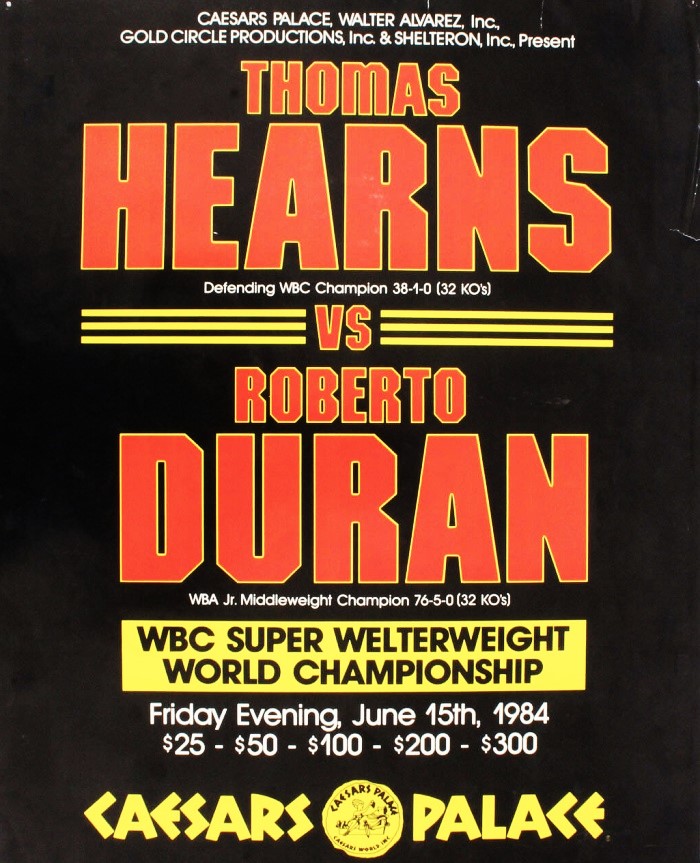
But while a showdown between Hearns and Hagler could have easily sold itself, the match-up lacked drama, a compelling storyline, that sense of inevitability which makes a prizefight an event. It hadn’t ripened into the clash which everyone, boxing fans and casual sports fans alike, couldn’t wait to see.
Enter Roberto Duran. The Panamanian legend, who had redeemed himself for the disgrace of his surrender to Leonard back in 1980, provided the impetus and the intrigue for what would become a legendary “superfight.” Without “Manos de Piedra’s” supporting role, the drama that was Hagler vs Hearns would never have captured the public’s imagination.
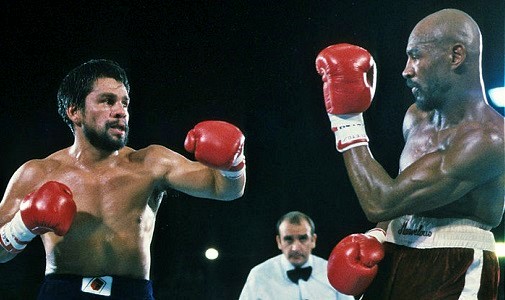
It was Roberto’s showing against Hagler the previous November which made his match with Hearns viable. A huge underdog, Duran became the first of the dominant middleweight king’s challengers to hear the final bell, while giving the much bigger Marvelous Marvin a surprisingly competitive fight. If Hagler took a decisive win over the savvy veteran and all-time great lightweight, the victory did nothing to enhance his stature. It was that rare instance where the loser of a high-profile match earned greater respect than the winner.
Hearns vs Duran then represented a huge opportunity for both boxers, but in fact only one was prepared to take full advantage. Following his inspired victory over Davey Moore and his valiant effort against Hagler, Roberto was riding high again, his reputation restored after the disgrace of “No Mas” two years before. But as in that ignoble defeat, his performance against Hearns inside the ring would be compromised by a lack of discipline outside of it.

Once Duran’s big paycheck from the Hagler fight had landed in his bank account, Roberto the party animal re-emerged with a vengeance. In a mood to celebrate after months of training and restraint, Duran hired his own personal orchestra to tour with him around Latin America so he could dance and sing and carouse night after night. The adulation of his fans, made more ardent for his having been lost and now found, went to his head, and all the whiskey and filet mignon to his belly. Reportedly, Duran entered training camp for the Hearns fight most reluctantly, and once there had to focus on losing weight more than anything else.
In stark contrast, Hearns had perhaps the most intense and productive camp of his entire career. Indeed, Emanuel Steward ranked it as such years later. “We had the best preparation in the world,” he told author Pete Hamill. That year Steward was involved in helping to prepare the national amateur team for the Olympics and so Hearns found himself working with such elite talents as Mark Breland, Pernell Whitaker and Frank Tate, along with world champions Milton McCrory and Mike McCallum. “It must have been one of the best camps in boxing history,” said Steward.
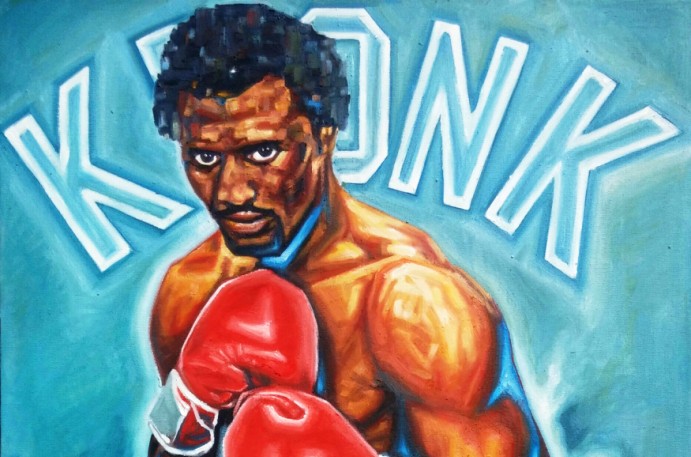
Thus, in retrospect, what transpired on that June night in Las Vegas isn’t so shocking. But at the time, it was, for one simple fact: no one, not even a deadly puncher like “The Hit Man,” knocks out Roberto Duran. It had never been done and no one expected it to happen now. The Panamanian they called “El Cholo” was renowned for his toughness, had never been stopped, and there was little reason to think Hearns might do serious damage to the same chin that Hagler couldn’t dent.
But then again, Duran had never faced a boxer with the unique gifts of Thomas Hearns, who knew how to make the most of his lanky frame and the leverage it could provide. Despite having scored just two stoppage wins in six contests since his defeat to Leonard in 1981, Hearns appeared extraordinarily confident in the days leading up to the match, and in fact, at one of the final press conferences, he openly predicted he would knock out the great “Manos de Piedra” in the second round.

And so he did, in large part because Hearns and Duran were at diametrically opposed positions on the arcs of their respective careers. Duran, at 33, came into the ring past his peak and something less than highly motivated, while Hearns, just 25, was primed and never sharper. From the opening bell, “The Hitman” took control, backing up the smaller man with aggressive footwork and a hard left jab, making excellent use of his twelve inch reach advantage. Generally a slow starter, Duran looked to take his time and find his rhythm but the taller, stronger, more assertive Hearns never gave him a chance.
With a minute left in the opener Hearns struck with two hard rights and chased Duran into the ropes. While the clearly uncomfortable Panamanian smiled and mugged, Hearns stalked and threw heavy punches with abandon, opening a cut over Roberto’s left eye. All in all, it was a disheartening opening round for Roberto and his fans, but it was about to get much worse.

Forcing Duran to retreat, Hearns got home a hard right to the head followed by a left to the body, and the combination clearly shook the smiling Panamanian. A jab to the belly landed flush and a second one brought Roberto’s hands down to parry it. Anticipating the opening, Hearns instantly smashed Duran on the jaw with a vicious straight right that floored the former lightweight terror for only the third time in his long career.
Duran beat the count but his body language and facial expression betrayed the fact he was in deep trouble. His legs looked to be gone, a fact confirmed when he tumbled to the canvas a second time as Hearns threw a relentless torrent of punches. Duran rose and, saved from further punishment by the bell, provided a comic image as he waved defiantly at Hearns while marching on unsteady pins to the wrong corner.
Round two saw the fulfillment of Hearns’ prediction. Give Roberto credit: he bravely stood his ground with his bigger, stronger and more powerful foe, even throwing a few right hands with bad intentions in an attempt to turn things around. But in addition to heart and courage, Duran was known for his defensive skill and against Hearns, this was absent. Instead of protecting his chin and using upper body and head movement, Duran stood straight up, his jaw a target Tommy couldn’t miss.
Thirty seconds into the round and the Panamanian legend was being swarmed by “The Hit Man” who, with his greater size and complete lack of respect, looked like a teenage bully sadistically tormenting a kid from grade school. Another right hand buckled Roberto’s legs and pinned him to the ropes and when he tried to force Hearns back, he found himself eating more leather. Dazed and looking to avoid punishment, Duran briefly clinched before backing into perfect punching range.
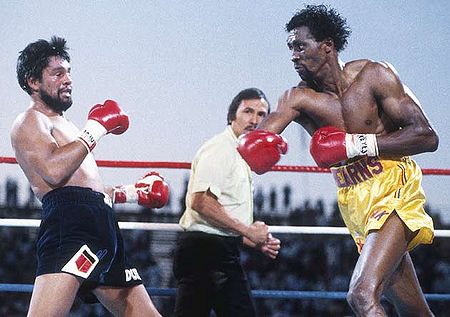
What followed was one of the single most devastating right hand missiles ever thrown by “The Motor City Cobra.” It detonated on the side of Roberto’s jaw, snapping his head like it was a speed bag, and the triple-crown champion, who had never come close to being stopped in his entire career, instantly went limp and collapsed to the canvas.
The feared warrior who had defeated Sugar Ray Leonard and battled Marvelous Marvin for fifteen back-and-forth rounds had been rendered helpless by Thomas Hearns in just four minutes, left face down in the resin dust, a sight few had imagined they might ever behold. The shocking victory instantly revitalized Hearns’ faded aura of menace, his past image as “The Hitman,” a deadly knockout artist.
It also transformed a prospective Thomas Hearns vs Marvelous Marvin Hagler contest from a major attraction to the fight absolutely everyone wanted to see, and all involved had one man to thank. It was Roberto Duran who made the Hagler vs Hearns match supremely viable and profitable. As his handlers worked to revive him in his corner, and as the scribes on press row composed their obituaries for the legendary career of “Manos de Piedra,” the drums were already beating in earnest for boxing’s next big superfight. And Hearns wasted no time in throwing down the gauntlet.
“I challenge Marvin Hagler,” said Tommy at the post-fight press conference. “I can see him in my mind now, shaking like a leaf on a tree.” — Michael Carbert

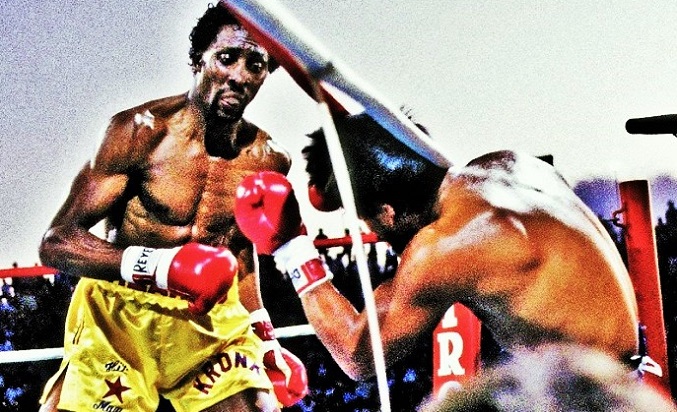

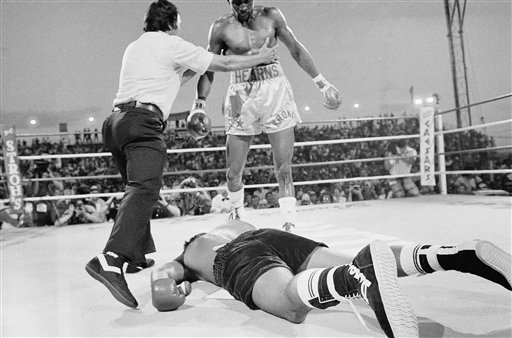

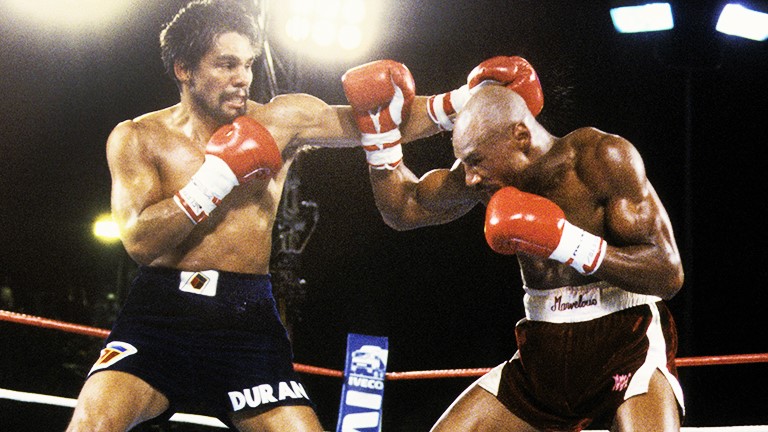
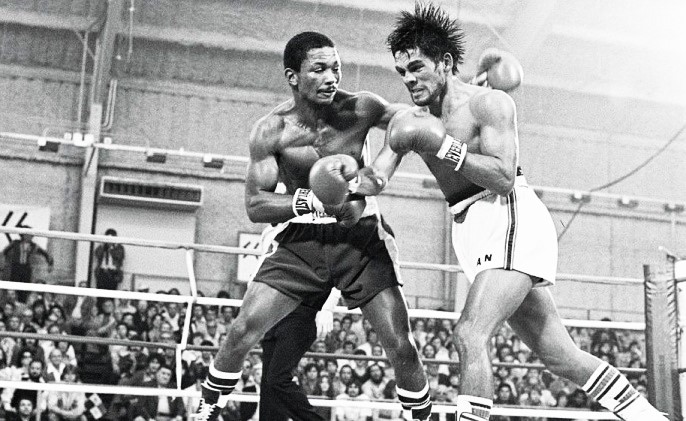
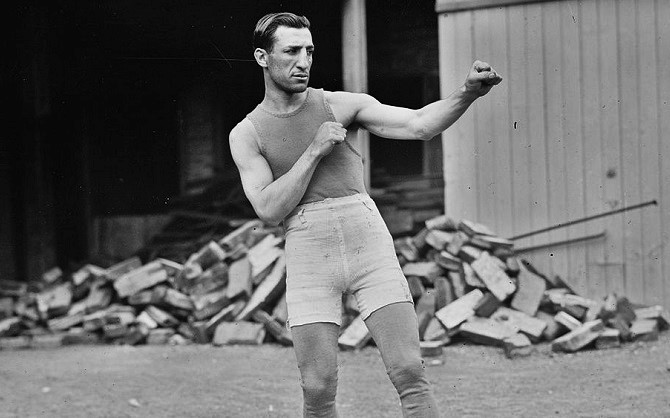
Hearns clearly fought a war-tattered Duran. He had already gone through so many wars that he should’ve retired. Hearns was in his prime. The brain can only take so much punishment before it collapses.That’s what we saw that night. In his prime Duran would’ve done what he did to sugar Ray Leonard.
Not so. Duran went on to capture more world titles. If anyone was a shell of himself after fighting Hearns, it was Hagler. After Hearns and Mugabi, Marvelous Marvin was a totally shot fighter.
Indeed. Duran has a very good defense and when he retired, he retired with money and health. Hearns on the other hand…
Good points, Rich. It wouldn’t of mattered what kind of shape Duran was in for this fight against Hearns. It’s just bad match up for Duran, style wise. As for Hagler, he did not look the same after that war with Hearns going into his fight with Mugabi. In hindsight, no wonder Ray Leonard stepped ahead of Hearns to get at Hagler… He too saw that Hagler was shot.
Rich, Duran was in terrible shape for this fight. I was at his training camp and novices were landing right hands. I told everyone Duran’s getting knocked out. As for Marvin after Mugabi and Hearns, yes he declined, but totally shot? That is just not so.
Leonard ducked both Hearns and Hagler… waiting for them to get past primes to fight them…. 12 rounds instead of 15
Sounds like Mayweather waiting or ducking fights until the time to fight, except Leonard actually fought every fighter out there sooner or later and faired well against most of them… His first obviously Duran in his prime which he lost on decision but that was a battle like few others.
In the documentary “The Kings”, Duran gives a plausible explanation for his poor performance against Hearns: he was partying it up, doping and boozing with three hookers in his room. I still think Hearns would have iced him regardless.